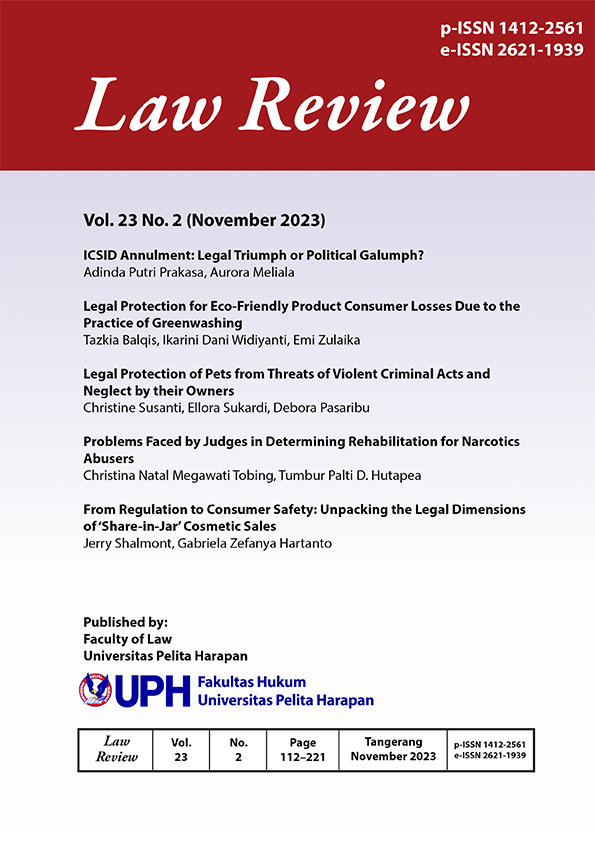Problems Faced by Judges in Determining Rehabilitation for Narcotics Abusers
DOI:
https://doi.org/10.19166/lr.v23i2.6479Keywords:
Assesment, Judges, RehabilitationAbstract
Addicts and victims of narcotic abuse should be placed in medical and social rehabilitation institutions. However, in empirical practice in the field, judges rarely exercise their powers to dive into a drug abuser accused of being brought to court through an assessment instrument. An assessment is needed to determine whether the defendant has a network of dealers or is just an addict or victim of narcotics abuse. The focus of this research problem is the obstacle for judges in determining the implementation of rehabilitation for narcotics abusers. The purpose is to identify the judge, in his decision, can determine medical rehabilitation for drug abusers in accordance with the mandate of the law. This research uses normative legal method based on positive legal studies with secondary data. The judge can consider whether the assessment results from the Integrated Assessment Team (TAT) allow them to be attached to the case file. Even the results of the assessment can be equated with expert testimony, which is an expert opinion written in a letter.
References
Laws and Regulations
Law Number 35 Year 2009 concerning Narcotics.
Law Number 25 year 2011 concerning The Implementation of Mandatory Reporting for Narcotics Addicts.
Regulation of the Head of BadanNarkotikaNasional (BNN) Number 11Year2014 concerning Procedures for Handling Suspects and/or Defendants of Narcotics Addicts and Victims of Narcotics Abuse into Rehabilitation Institutions.
Supreme Court Circular (SEMA) Number 4 Year 2010 concerning Placement of Abuse, Abuse Victims and Narcotics.
Supreme Court Circular (SEMA) Number 3 Year 2011 concerning Placement of Narcotics Abuse Victims in Medical Rehabilitation and Social Rehabilitation Institutions.
Supreme Court Circular (SEMA) Number 3 Year 2015 concerning the Enforcement of the Formulation of the Plenary Meeting Results of the Supreme Court Chamber Year 2015 as Guidelines for the Implementation of Duties for Courts.
Supreme Court Circular (SEMA)Number 1 Year 2017reaffirmed of Supreme Court Circular (SEMA) Number 3 Year 2015 concerning the Enforcement of the Formulation of the Plenary Meeting Results of the Supreme Court Chamber Year 2015 as Guidelines for the Implementation of Duties for Courts.
Books
Alkostar, Artidjo. Metode Penelitian Hukum Profetik. Yogyakarta: Fakultas Hukum Universitas Islam Indonesia Press, 2018.
Arief, Barda Nawawi. Bunga Rampai Kebijakan Hukum Pidana. Jakarta: Kencana, 2008.
Badan Narkotika Nasional. Catalog of Terms and Conditions for Rehabilitation of the National Narcotics Agency. Jakarta: National Narcotics Agency, 2018.
Dahlan. Problematika Keadilan dalam Penerapan Pidana Terhadap Penyalahgunaan Narkotika Indonesia. Yogyakarta: Deepublish, 2018.
Fransiska, Asmin. Decriminalisation Approach to Drug Use From a Human Rights Perspective. London: Lap Lambert Academic Publishing, 2018.
Hutapea, Tumbur Palti D., et.al. Rekonstruksi Ideal Implementasi Hukuman Rehabilitasi Terhadap Penyalahgunaan Narkotika. Jakarta: Kencana, 2021.
Hutapea, Tumbur Palti D., dan Sri Gilang MSRP. Implementasi Sistem Pemidanaan Perkara Penyalah Guna Narkotika di Lingkungan Pengadilan Militer. Jakarta: Prenadamedia, 2019.
Iskandar, Anang. Politik Hukum Narkotika. Jakarta: PT. Elex Media Komputindo, 2020.
Tim Pokja Laporan Tahunan MARI. Laporan Tahunan 2019 Mahkamah Agung Republik Indonesia: Keberlanjutan Modernisasi Peradilan. Jakarta: Supreme Court of Republic of Indonesia, 2020. https://kepaniteraan.mahkamahagung.go.id/images/laporan_tahunan/LAPTAH%20030220.pdf.
Journal Articles
Borry WD, Marryo, Hardisman, Rika Susanti. “Analisis Perumusan Rekomendasi Tim Assesmen Terpadu dan Penerimaan Hakim BNN Provinsi Sumatera Barat.” Human Care Journal 4, no.3 (2019): 206-219. http://dx.doi.org/10.32883/hcj.v4i3.614.
Ginting, Jamin. “Sanksi Kerja Sosial Sebagai Alternatif Bentuk Pemidanaan Dalam Sistem Hukum di Indonesia.” Law Review 19, no. 3 (2020): 246-267. http://dx.doi.org/10.19166/lr.v19i3.2098.
Hadiansyah, Risya, Nur Rochaeti. “Penerapan Rehabilitasi Terhadap Anak Penyalahguna Narkotika.” Jurnal Pembangunan Hukum Indonesia 4, no. 1 (2022): 1-13. https://doi.org/10.14710/jphi.v4i1.1-13.
Hidayatun, Siti, Yeni Widowaty. “Konsep Rehabilitasi Bagi Pengguna Narkotika yang Berkeadilan.” Jurnal Penegakan Hukum dan Keadilan 1, no. 2 (2020): 166-181. https://doi.org/10.18196/jphk.1209
Hutapea, Tumbur Palti D. “Penerapan Rehabilitasi Medis dan Sosial Bagi Prajurit TNI Dalam PutusanPengadilan.” Jurnal Hukum dan Peradilan 7, no. 1 (2018): 67-86. https://doi.org/10.25216/jhp.7.1.2018.67-86.
Mustafa, Cecep, Margaret Malloch, and Niall Hamilton Smith. “Judicial Perspective on the Sentencing of Minor Drugoffenders in Indonesia: Discretionary Practice and Compassionate Approaches.” Crime, Law and Social Change 74, (2020): 297-313. https://doi.org/10.1007/s10611-020-09896-0.
Rahmanto,Tony Yuri. “Kepastian Hukum Bagi Pengguna Penyalahgunaan Narkotika: Studi Kasus di Provinsi Jawa Timur.” Jurnal Penelitian Hukum De Jure 17, no. 2 (2017): 265-282. http://dx.doi.org/10.30641/dejure.2017.V17.265-282
Rizky, Fauzi. “Pelaksanaan Rehabilitasi Terhadap Pecandu, Penyalahguna dan Korban Narkotika.” Riau Law Journal 1, no. 1, (2017): 102-123. http://dx.doi.org/10.30652/rlj.v1i1.4180
Wulandari, Sri. “Rehabilitasi sebagai Upaya Pemerintah dalam Penanggulangan Penyalahguna Narkotika.” Jurnal Spektrum Hukum 14, no. 2 (2017): 291-308. http://dx.doi.org/10.35973/sh.v14i2.1083
News or Magazine Articles
Hiariej, Eddy OS. “Quo Vadis Pemasyarakatan.” Kompas, January 27, 2016. https://www.kompas.id/baca/opini/2021/01/27/quo-vadis-pemasyarakatan/.
Website Contents
KBBI. “Penilaian.” Accessed July 12, 2023. https://kbbi.kemdikbud.go.id/entri/penilaian.
KBBI. “Penyalahgunaan.” Accessed January 6, 2023. https://kbbi.kemdikbud.go.id/entri/penyalahgunaan.
Downloads
Published
How to Cite
Issue
Section
License
Copyright (c) 2023 Christina Natal Megawati Tobing

This work is licensed under a Creative Commons Attribution-NonCommercial 4.0 International License.
Authors who publish with this journal agree to the following terms:
1) Authors retain copyright and grant the journal right of first publication with the work simultaneously licensed under a Creative Commons Attribution License (CC-BY-SA 4.0) that allows others to share the work with an acknowledgement of the work's authorship and initial publication in this journal.
2) Authors are able to enter into separate, additional contractual arrangements for the non-exclusive distribution of the journal's published version of the work (e.g., post it to an institutional repository or publish it in a book), with an acknowledgement of its initial publication in this journal.
3) Authors are permitted and encouraged to post their work online (e.g., in institutional repositories or on their website). The final published PDF should be used and bibliographic details that credit the publication in this journal should be included.





